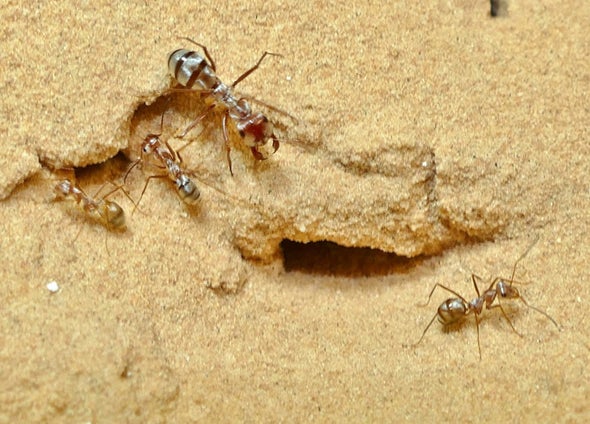(单词翻译:单击)
听力文本
This is Scientific American's 60-second Science, I'm Susanne Bard.
The Sahara Desert, where daytime temperatures can reach 140 degrees Fahrenheit. Not many organisms can survive in this harsh environment. But an insect called the Saharan silver ant thrives. They scurry out onto the sand from their protected nests to gather up the carcasses of less fortunate insects that have died from the heat.
"The hotter the day, the more insect bodies they will find. The more food they have."
Sarah Pfeffer, an animal behaviorist at Ulm University in Germany. She says that to avoid sinking into the Saharan sand dunes, where they could meet the same fate as their lunch, silver ants have to be fast.
To document just how quickly the ants move, Pfeffer and her colleagues set up high-speed cameras above a channel between the entrance to the hungry ants' nest and a food source. The researchers recorded top speeds approaching 35 inches per second.
"But if you really look how big the animals are, and you calculate the body length per second, you come up with a walking speed that is an astonishing 108 body lengths per second."

That figure makes them the fastest known ant on the planet. By comparison, cheetahs top out at about 16 body lengths per second.
The videos revealed how the ants achieve such prodigious speeds. As they accelerate, their leg movements become synchronized. They increase their stride length by bringing all six feet off of the sand at once, which Pfeffer describes as a gallop.
"Really, all legs are lifted from the ground. They are in air, but it's not jumping. It's a very smooth run that they have."
Pfeffer says they're thus faster than a closely related ant species called Cataglyphis fortis, which has longer legs but a less impressive airborne phase. That ant only reaches about 24 inches per second, or two thirds of the silver ant's max.
The study appears in the Journal of Experimental Biology.
The Saharan silver ants' breakneck speeds may be impressive, but two insects are even faster: the California coastal mite and the Australian tiger beetle, both of which also thrive at near-lethal temperatures. Seems that to beat the heat, it pays to be fleet.
Thanks for listening for Scientific American's 60-second Science. I'm Susanne Bard.
参考译文
这里是科学美国人——60秒科学系列,我是苏珊娜·巴德。
撒哈拉沙漠白天的温度可达到华氏140度。没有多少生物能在这种恶劣的环境中生存。但一种叫撒哈拉银蚁的昆虫却在这里茁壮成长。它们从被保护的蚁穴中迅速跑到沙地上,收集死于高温的不幸昆虫的尸体。
“天气越热,它们发现的昆虫尸体就越多,它们的食物也就越多。”
德国乌尔姆大学的动物行为学家萨拉·费弗尔说到。她表示,为了避免陷入撒哈拉沙丘中,即避免遭遇与它们所找到的午餐一样的命运,银蚁不得不行动迅速。
为了记录下银蚁的移动速度有多快,费弗尔和同事在饥饿银蚁的巢穴入口和食物来源之间的通道上方安装了高速摄像机。研究人员记录的最高速度接近每秒35英寸。
“但如果你仔细观察银蚁的体型,并计算它们每秒移动多少体长,你就能算出它们每秒108个体长的惊人行走速度。”
这一速度使它们成为地球上已知的速度最快的蚂蚁。相比之下,猎豹的最快速度约为每秒16个身长。
视频揭示了银蚁是如何达到如此惊人的速度的。当它们加速时,它们的腿会同时移动。它们通过一下将所有六条腿从沙地上移开来增加步幅,费弗尔称这为“疾驰”。
“的确是所有腿都从地上腾空。腿在空中,但没有跳跃。这是它们非常平稳的奔跑过程。”
费弗尔表示,它们因此比一种名为箭蚁的近亲物种的速度更快,箭蚁腿更长,但空中飞行情况却不尽如人意。箭蚁的速度只有每秒24英寸,也就是银蚁最高速度的三分之二。
这项研究发表在《实验生物学杂志》上。
撒哈拉银蚁的惊人速度可能令人印象深刻,但有两种昆虫的速度比其更快:加州海岸螨虫和澳大利亚虎甲虫,这两种昆虫也在接近致命的温度下茁壮成长。看起来,为了抵御酷热,就得跑得快。
谢谢大家收听科学美国人——60秒科学。我是苏珊娜·巴德。
译文为可可英语翻译,未经授权请勿转载!
重点讲解
重点讲解:
1. gather up 收集;收拢;归拢;
He gathered the leaves up off the ground.
他将地上的树叶全部收了起来。
2. set up 创建;建立;安排;组建;
A new telegraph line has been set up between the two cities.
那两个城市之间架设了一条新的电报线。
3. come up with 想出,提出(计划、想法等);
No one has come up with a definitive answer as to why this should be so.
对于为什么应该是这样,还没有人想出最终确定的答案。
4. at once 同时;一起;立即;马上;
His story was seen through at once.
他的谣言一下就被识破了。


